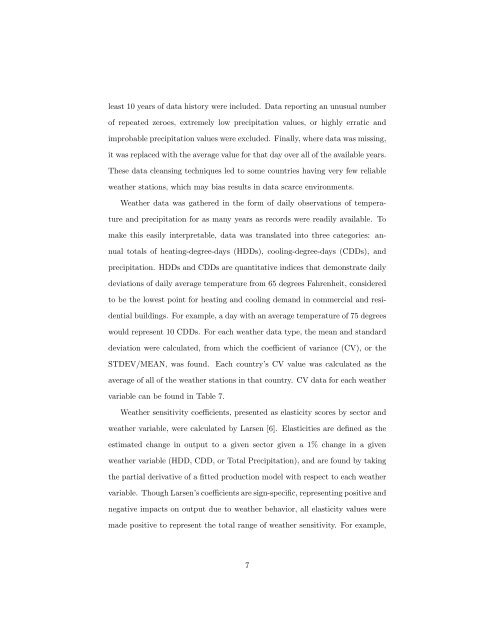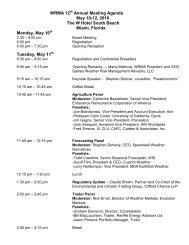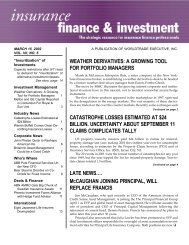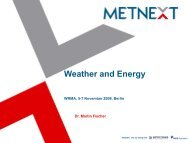Global Weather Sensitivity: A Comparative Study - albertotroccoli.org
Global Weather Sensitivity: A Comparative Study - albertotroccoli.org
Global Weather Sensitivity: A Comparative Study - albertotroccoli.org
- No tags were found...
Create successful ePaper yourself
Turn your PDF publications into a flip-book with our unique Google optimized e-Paper software.
least 10 years of data history were included. Data reporting an unusual number<br />
of repeated zeroes, extremely low precipitation values, or highly erratic and<br />
improbable precipitation values were excluded. Finally, where data was missing,<br />
it was replaced with the average value for that day over all of the available years.<br />
These data cleansing techniques led to some countries having very few reliable<br />
weather stations, which may bias results in data scarce environments.<br />
<strong>Weather</strong> data was gathered in the form of daily observations of temperature<br />
and precipitation for as many years as records were readily available. To<br />
make this easily interpretable, data was translated into three categories: annual<br />
totals of heating-degree-days (HDDs), cooling-degree-days (CDDs), and<br />
precipitation. HDDs and CDDs are quantitative indices that demonstrate daily<br />
deviations of daily average temperature from 65 degrees Fahrenheit, considered<br />
to be the lowest point for heating and cooling demand in commercial and residential<br />
buildings. For example, a day with an average temperature of 75 degrees<br />
would represent 10 CDDs. For each weather data type, the mean and standard<br />
deviation were calculated, from which the coefficient of variance (CV), or the<br />
STDEV/MEAN, was found.<br />
Each country’s CV value was calculated as the<br />
average of all of the weather stations in that country. CV data for each weather<br />
variable can be found in Table 7.<br />
<strong>Weather</strong> sensitivity coefficients, presented as elasticity scores by sector and<br />
weather variable, were calculated by Larsen [6]. Elasticities are defined as the<br />
estimated change in output to a given sector given a 1% change in a given<br />
weather variable (HDD, CDD, or Total Precipitation), and are found by taking<br />
the partial derivative of a fitted production model with respect to each weather<br />
variable. Though Larsen’s coefficients are sign-specific, representing positive and<br />
negative impacts on output due to weather behavior, all elasticity values were<br />
made positive to represent the total range of weather sensitivity. For example,<br />
7











